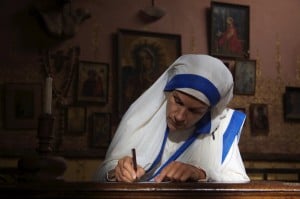At the beginning of each of the ten videos in Fr. Robert Barron’s “Catholicism” series, there is a scene in which thousands of white rose petals drift downward from the ceiling at Rome’s Basilica di Sa nta Maria Maggiore (St. Mary Major). It’s a breathtaking symbol of the “miracle of the snow”—the rare summer snowfall which, according to legend, fell on August 5, 352, on the Esquiline Hill, one of the famed “Seven Hills” of Rome.
nta Maria Maggiore (St. Mary Major). It’s a breathtaking symbol of the “miracle of the snow”—the rare summer snowfall which, according to legend, fell on August 5, 352, on the Esquiline Hill, one of the famed “Seven Hills” of Rome.
It’s a scene that’s recreated each year on August 5, when the Basilica celebrates the feast of Our Lady of the Snows. First, the petals fall from the ceiling during Mass; then, as night falls on the city, there is a simulated “snowfall” in the square outside the Basilica, with sound, light and artificial snow.
But not this year! This year, the petal display in the Basilica occurred as planned, but the festival in the square has been postponed until August 15, the Solemnity of the Immaculate Conception.
That’s because this year, vandals stole the truck.
I can’t help but imagine the thieves, desperadoes, quintessential bad guys, driving away with their booty, then popping open the truck at their safe house. “What did we get?” they wonder. “Computers and office equipment? Metals to be melted down? Automobile tires? But wait…. No, no…. We’ve got…. ROSE PETALS! #@!E%*!!”
Actually, what was stolen, according to event organizer Cesare Esposito, was sound and light equipment. I needed a laugh today, though, so I’m succumbing to knee-slapping levity at the expense of the group I now unofficially dub the Sancta Maria Scoundrels. Stay tuned for Part 2 of the annual celebration for Our Lady of the Snows, on the 15th of August.
Now, More About That “Miracle”
The Catholic Encyclopedia tells the story of the basilica’s origins:
“During the pontificate of Liberius, the Roman patrician John and his wife, who were without heirs, made a vow to donate their possessions to the Virgin Mary. They prayed that she might make known to them how they were to dispose of their property in her honour. On 5 August, at the height of the Roman summer, snow fell during the night on the summit of the Esquiline Hill. In obedience to a vision of the Virgin Mary which they had the same night, the couple built a basilica in honour of Mary on the very spot which was covered with snow.
From the fact that no mention whatever is made of this alleged miracle until a few hundred years later, not even by Sixtus III in his eight-line dedicatory inscription … it would seem that the legend has no historical basis.” The legend is first reported only after the year 1000. It may be implied in what the Liber Pontificalis, of the early 13th century, says of Pope Liberius: “He built the basilica of his own name (i.e. the Liberian Basilica) near the Macellum of Livia”. Its prevalence in the 15th century is shown in the painting of the Miracle of the Snow by Masolino da Panicale.
So the story may be only a pious legend; but inside the beautiful Basilica of Santa Maria Maggiore, high over the side altar in the left transept, is a beautiful golden bas relief depicting the story. In 2003, while working as conference director for Legatus, I led a group of pilgrims to Rome and to the four papal basilicas. Cardinal Bernard Law, then-archpriest of the Basilica of St. Mary Major, celebrated Mass for us at the side altar under the great artwork, then explained its history to our group.
The painting included here is from a triptych which can be seen in the National Museum and Gallery of Capodimonte in Naples, Italy. That’s Pope Liberius with the small snow shovel, marking the spot where a chapel should be erected honoring the Virgin Mary.
And here, during the Gloria on the feast, the rose petals fall.











